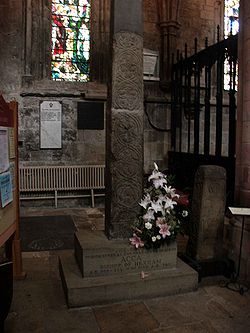
Acca of Hexham
Encyclopedia

Bishop of Hexham
The Bishop of Hexham was an episcopal title which took its name after the market town of Hexham in Northumberland, England. The title was first used by the Anglo-Saxons in the 7th and 9th centuries, and then by the Roman Catholic Church in the 19th century....
.
Born in Northumbria
Northumbria
Northumbria was a medieval kingdom of the Angles, in what is now Northern England and South-East Scotland, becoming subsequently an earldom in a united Anglo-Saxon kingdom of England. The name reflects the approximate southern limit to the kingdom's territory, the Humber Estuary.Northumbria was...
, Acca first served in the household of Bosa
Bosa of York
Bosa was a Northumbrian, educated at the great Abbey of Whitby under the abbess Hilda. He later joined the brethren there as a monk and became a noted scholar....
, the future Bishop of York
Archbishop of York
The Archbishop of York is a high-ranking cleric in the Church of England, second only to the Archbishop of Canterbury. He is the diocesan bishop of the Diocese of York and metropolitan of the Province of York, which covers the northern portion of England as well as the Isle of Man...
, but later attached himself to Saint Wilfrid
Wilfrid
Wilfrid was an English bishop and saint. Born a Northumbrian noble, he entered religious life as a teenager and studied at Lindisfarne, at Canterbury, in Gaul, and at Rome; he returned to Northumbria in about 660, and became the abbot of a newly founded monastery at Ripon...
, possibly as early as 678, and accompanied him on his travels. On the return from their second journey to Rome in 692, Wilfrid was reinstated at Hexham and made Acca abbot of St Andrew's monastery
Hexham Abbey
Hexham Abbey is a place of Christian worship dedicated to St Andrew and located in the town of Hexham, Northumberland, in northeast England. Since the Dissolution of the Monasteries in 1537, the Abbey has been the parish church of Hexham.-History:...
there. After Wilfrid's death in 709 Acca succeeded him as bishop.
Acca tackled his duties with much energy, in ruling the diocese and in conducting the services of the church. He also carried on the work of church building and decorating started by Wilfrid. He once brought to the North a famous cantor
Cantor (church)
A cantor is the chief singer employed in a church with responsibilities for the ecclesiastical choir; also called the precentor....
named Maban, who had learned in Kent the Roman traditions of psalmody handed down from Gregory the Great through Saint Augustine
Augustine of Canterbury
Augustine of Canterbury was a Benedictine monk who became the first Archbishop of Canterbury in the year 597...
.
He was also famous for his theological learning; his theological library was praised by Bede
Bede
Bede , also referred to as Saint Bede or the Venerable Bede , was a monk at the Northumbrian monastery of Saint Peter at Monkwearmouth, today part of Sunderland, England, and of its companion monastery, Saint Paul's, in modern Jarrow , both in the Kingdom of Northumbria...
. He was known also for his encouragement of students by every means in his power. It was Acca who persuaded Stephen of Ripon (Eddius) to take on the Life of St. Wilfrid
Vita Sancti Wilfrithi
The Vita Sancti Wilfrithi or Life of St Wilfrid is an early 8th-century hagiographic text recounting the life of the Northumbrian bishop, Wilfrid. Although a hagiography, it has few miracles, while its main concerns are with the politics of the Northumbrian church and the history of the...
, and he lent many materials for the Historia ecclesiastica gentis Anglorum
Historia ecclesiastica gentis Anglorum
The Historia ecclesiastica gentis Anglorum is a work in Latin by Bede on the history of the Christian Churches in England, and of England generally; its main focus is on the conflict between Roman and Celtic Christianity.It is considered to be one of the most important original references on...
to Bede, who dedicated several of his most important works, especially those dealing with Holy Scripture, to him.
For reasons now unknown Acca either withdrew, or was driven from, his diocese in 732. Some sources say he became bishop of Whithorn in Galloway
Galloway
Galloway is an area in southwestern Scotland. It usually refers to the former counties of Wigtownshire and Kirkcudbrightshire...
, while others claim he founded a see on the site of St. Andrews, bringing with him relics collected on his Roman tour. He was nevertheless still buried at Hexham. Two finely carved crosses, fragments of one of which still remain, were erected at the head and foot of his grave.
He was revered as a saint immediately after his death. His body was translated at least three times: in the early 11th century, by Alfred of Westow, sacrist of Durham
Durham
Durham is a city in north east England. It is within the County Durham local government district, and is the county town of the larger ceremonial county...
; in 1154, at the restoration of the church, when the relics of all the Hexham saints were put together in a single shrine; and again in 1240. His feast day was 20 October. The translation of his relics
Translation (relics)
In Christianity, the translation of relics is the removal of holy objects from one locality to another ; usually only the movement of the remains of the saint's body would be treated so formally, with secondary relics such as items of clothing treated with less ceremony...
was commemorated on 19 February.
The only surviving writing of Acca's is a letter addressed to Bede and printed in his works (see also Raine below).
External links
- Hexham Abbey webpage
- Prosopography of Anglo Saxon England entry for Acca
- Catholic Online entry for St Acca
- Catholic Encyclopedia entry for St Acca
Attribution

